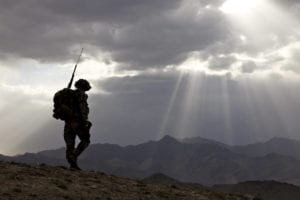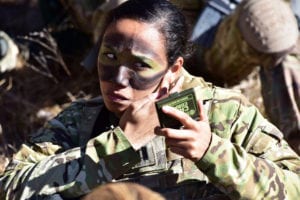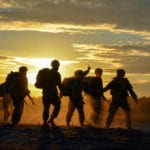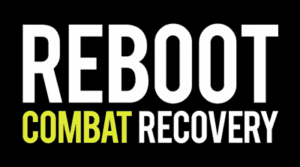On April 14, 2021, President Biden announced the full withdrawal of U.S. Forces from Afghanistan by September 11, 2021 – the anniversary of the terrorist attacks 20 years earlier. This announcement was considered long overdue by some, but foolhardy by others.
Everything Lost?
 But among those who have borne the burden of the fight – and have been wounded or lost their closest friends, the response may be somewhat different. As the Veterans of America’s longest war see images of empty base camps on the news and hear reports of the Taliban doing terrible things again, they may be asking these questions. “Was it all a waste?” “Were all those sacrifices in vain?” “Did they accomplish nothing?” “Will the ground we fought so hard to gain and the objectives we sacrificed so much for be lost?”
But among those who have borne the burden of the fight – and have been wounded or lost their closest friends, the response may be somewhat different. As the Veterans of America’s longest war see images of empty base camps on the news and hear reports of the Taliban doing terrible things again, they may be asking these questions. “Was it all a waste?” “Were all those sacrifices in vain?” “Did they accomplish nothing?” “Will the ground we fought so hard to gain and the objectives we sacrificed so much for be lost?”
I’m sure that many Soldiers welcome a respite from combat duty. They’ll have little grief over one less opportunity to deploy. However, lingering in the minds of all Soldiers is the fear that they might have to go back there in years to come and retake everything that was lost.
Never Ending Fight
I’d like to speak for a few moments to those who feel some fear and anguish over our withdrawal from Afghanistan. Let’s begin by putting things in perspective.

Firstly, many of the objectives of the War in Afghanistan were met. As one member of the Scowcroft Center for Strategy and Security stated, “Al Qaeda was evicted, the 2001 Taliban government was smashed, and Washington made the point that no one attacks the United States with impunity.” Osama bin Laden, who started the war, was put on the run, and killed. The goals in Afghanistan have certainly been expanded over the years. But the purposes of keeping pressure on the Taliban, and stabilizing the government in neighboring Pakistan, were well-served and successful.
Second, let’s understand the nature of the military’s mission. It’s on-going and never-ending. Just as the human body’s immune system must wage a never-ending war against invading pathogens, so the military must continually fight for the health and survival of our nation. Yes, the immune system that killed one infection and brought health back to the body will have to fight the same battle again. But that’s the nature of the job. It’s a ceaseless vigil.
True, the mess that we cleaned up in one country will possibly mess up again. But there are many tasks that share this disadvantage. Do you remember the computer animated superhero, Mr. Incredible? In the 2004 movie, Mr. Incredible made a profound point about his job. “No matter how many times you save the world, it always manages to get in jeopardy again. Sometimes I just want it to ‘stay saved’ – you know – for a little bit. I feel like the maid sometimes. I just cleaned up this mess, can we keep it clean – for ten minutes?” Superman would agree that it’s a never-ending battle for truth, justice, and the American way.
On Going Battle
In a very real way, every Soldier, Sailor, Airman, Marine, and Coastguardsman is a superhero. They are forever answering the call to crush the oppression of the wicked. But it’s an on-going battle that has no end. Thus, the things you once fought hard to repair will inevitably become broken again. But don’t ever view your efforts as a waste. It’s the job that must be done, repeatedly.

It’s sort of like the difference between the workers who built the Golden Gate Bridge and the workers who must unceasingly work for its upkeep. The first crew had a clean-cut job which lasted only a few years. Some military operations are like that. But I suspect that most military missions parallel the work of the latter crew who never cease to repair, scrape, and re-paint the bridge. Their work will never end. Yet, without their labors, rust and damage will inevitably take over and bring that bridge crashing down. In the same way, without the Soldier’s unceasing efforts, freedom will come crashing down.
Third, don’t forget the lesson you learned from your previous deployments. There are respites along the way, and you’re not alone in the battle. With this, you are only responsible for your performance in the mission. Most deployments to Afghanistan involved relieving a unit in place, carrying on the mission for a year or nine months, and then passing it on to the next unit.
Yes, it’s possible that the unit which followed yours might have dropped the ball and failed. But you are not responsible for their performance, only your own. Like a relay runner who neither begins nor finishes the race, you took the baton, ran your hardest, then successfully passed it on to the next runner. If you did this, then you were successful in your mission.
Apply this lesson to the War in Afghanistan. Every Soldier who fought and died in Afghanistan fulfilled their duty on the side of justice and freedom. They fought against terrorism and spent their lives in a worthy cause. And, particularly for the War in Afghanistan, those brave Soldiers took the fight from America’s heartland to the home of our attackers. They brought the war to the doorstep of their enemies and prevented any further attacks like those which took place on September 11, 2001. Wasn’t this a worthy cause?
Greater Goal
Fourth, don’t lose sight of the bigger picture and of the importance of your contribution. There’s a temptation that comes with missions which are too large to grasp. Often our own pain and struggles can make us lose sight of the greater war that’s going on and of the importance of our contribution. The mission is huge. It’s the ages-long conflict between good and evil – a battle which good cannot afford to lose.

As an analogy, think of the great Gothic cathedrals of Europe. The cathedral of Notre Dame in Paris took 182 years to complete. This was during a period when the average Parisian had a life expectancy of only 45 years. Meaning that the craftsman who began the massive project in 1160 had no hope of ever seeing his work completed – nor did his son or grandson. Each of them had to content himself that he was part of a team – a chronological team, a long succession of laborers. The mission was greater than any individual or any one generation. So, they had to take up the mission from their predecessor and build upon it. Then they entrusted their gains to a successor before closing their eyes in death. Yet, in every case, each generation’s contribution was indispensable and integral to mission success.
The same is true in the awesome age-long battle between good and evil. Don’t lose sight of the greater goal, nor of the destructive ramifications if we fail in our contribution.
Victory Over Defeat
Fifth, in this ages-long battle, there will always be the gaining and the giving of ground. There will always be battles lost and battles won. It will resemble a back-and-forth tug-o-war. But don’t lose heart, for good must always put forth the effort. Even though our victories are interspersed with defeats, those victories are never nullified by the defeats.

As an analogy, think about some of the towering rock formations of the desert Southwest. Consider, for instance, the rock pinnacle named Lighthouse Peak, in the Palo Duro Canyon of the Texas Panhandle. This towering formation rises 3,100 feet above sea level. Its survival has depended on the extremely resistant layer of caliche (a very hard limestone) that caps its top and some other intermittent layers of hard limestone. But this sturdy formation consists mostly of soft mudstones and gypsum. Obviously, if the whole of Lighthouse Peak consisted of the brightly colored mudstone and the white streaks of gypsum, it would have dissolved long ago. All would have quickly eroded away. But the presence of a few hard and weather-resistant layers makes all the difference in the Lighthouse’s survival. As such, the soft layers do not cancel out or nullify the hard ones.
Those few hard layers in Lighthouse Peak are like the few hard-fought victories of the good. The evil-resisting forces of good will keep the nation standing, despite the weaknesses of the evil. They’ll uphold the world, regardless of the presence and successes of the corrosive forces of evil. It may look like the forces of evil will bring the world down – especially when they dominate history. But the costly and courageous efforts of the good will stabilize and save our world. They will never be nullified by any advances of evil.
Final Piece of The Puzzle
And, finally, remember that all our wars should be viewed as battles in a far greater conflict. Many would rather forget the painful struggles in Korea (33,000 American lives lost from 1950-1953) and Vietnam (58,000 lives lost from 1961-1973). But the true meaning of those conflicts lies in their relation to the greater Cold War.

For without taking those stands against Soviet aggression, America would not have been victorious in the Cold War – which was considered by many un-winnable! Yes, I recall critics telling me, “I’d rather be Red than dead,” and they said this right up to the point the Soviet Union collapsed. They championed the cause of that evil empire right up to its downfall.
But they were wrong. Neither Korea, nor Vietnam, nor Afghanistan, nor Iraq were senseless wastes of manhood. In those battles, though some were lost, we have won the greater victory – the survival and success of our nation. We have brought the fight to the enemy’s doorstep and proven our resolve to fight for what we believe.
In a way, the War in Afghanistan is like a single piece of a jigsaw puzzle. That piece of a puzzle is hard or impossible to understand when viewed as an isolated object. Its irregular shape and confusing color make no sense to us. But when it’s viewed within the big picture, in its place with all the other pieces, then we’ll understand its meaning and purpose.
In the same way, let’s withhold our judgments on the War in Afghanistan. We may be tempted to wonder if it all was a waste. But I assure you, it was not. It met its objectives. It prevented further acts of terrorism in America. And, viewed from a more informed perspective, we’ll see that it was a critical conflict in the great struggle between good and evil.
PRAYER
Dear Father in heaven, the survival of our nation or any nation has never depended upon the opinions of the majority, but on the sacrifices and courage of the few. Please, dear God, continue to raise up men and women of faith and courage who are willing to confront and destroy the oppression of the wicked. Without their faithful contributions our nation cannot survive. We ask this in Jesus’ holy name, Amen.
Information from: https://www.defense.gov/Explore/News/Article/Article/2573268/biden-announces-full-us-troop-withdrawal-from-afghanistan-by-sept-11/; https://en.wikipedia.org/wiki/War_in_Afghanistan_(2001%E2%80%93present; https://foreignpolicy.com/2021/04/16/is-leaving-afghanistan-misguided-or-overdue/







